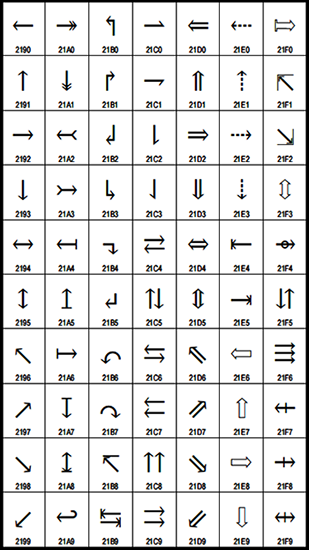

Archived from the original on 3 December 2016. ^ "RFC 1345 - Character Mnemonics and Character Sets"."Kirjainten tarinoita" (PDF) (in Finnish). Archived from the original on 21 August 2014.
#Unicode caret code
"ASCII: American Standard Code for Information Infiltration".

The compiler prints out the faulty line of code and uses a single caret on the next line, padded by spaces, to give a visual indication of the error location. Multiple carets may indicate the comment is replying to or relating to the post above that correlates with the number of carets used, or to "underscore" the correct portion of the previous post, or may simply be used for emphasis.Ī similar use has been adopted by programming language compilers such as Java compiler to point out where a compilation error has occurred. In addition to the arrow usage, it can also mean that the user who posted the ^ agrees with the above post. In internet forums, social networking sites such as Facebook, or in online chats, one or more carets may be used beneath the text of another post, representing an upwards-pointing arrow to that post. For instance to pass a less-than sign as an argument to a program you type ^<.
#Unicode caret windows
The command-line interpreter, cmd.exe, of Windows uses the caret to escape reserved characters (most other shells use the backslash). Often seen as caret notation to show control characters, for instance ^A means the control character with value 1. The upward-pointing arrow is now used to signify hyperoperations in Knuth's up-arrow notation. As Isaac Asimov described it in his 1974 " Skewered!" essay (on Skewes' number), "I make the exponent a figure of normal size and it is as though it is being held up by a lever, and its added weight when its size grows bends the lever down." The use of the caret for exponentiation can be traced back to ALGOL 60, which expressed the exponentiation operator as an upward-pointing arrow, intended to evoke the superscript notation common in mathematics. It is also used to indicate a superscript in TeX typesetting. In mathematics, the caret can signify exponentiation ( 3^5 for 3 5), where the usual superscript is not readily usable (as on some graphing calculators). Surrogate symbol for superscript and exponentiation
#Unicode caret update
In the case of Node.js, a caret allows any kind of update, unless it is seen as a "major" update as defined by semver. Node.js uses the caret in package.json files to signify dependency resolution behavior being used for each particular dependency.
#Unicode caret for mac os x
In Apple's C extensions for Mac OS X and iOS, carets are used to create blocks and to denote block types. NET reference types are accessed through a handle using the ClassName^ syntax. In Smalltalk, the caret is the method return statement. Pascal uses the caret for declaring and dereferencing pointers. RFC 1345 recommends that the character be transcribed as digraph '> when required. In regular expressions, the caret is used to match the beginning of a string or line if it begins a character class, then the inverse of the class is to be matched.ĪNSI C can transcribe the caret in the form of the trigraph ?', as the character was originally not available in all character sets and keyboards.Ĭ++ additionally supports tokens like xor (for ^) and xor_eq (for ^=) to avoid the character altogether. It can signify exponentiation, the bitwise XOR operator, string concatenation, and control characters in caret notation, among other uses. The symbol ^ has many uses in programming languages, where it is typically called a caret. This caret is not to be confused with other chevron-shaped characters, such as the turned v or the logical AND, which may occasionally be called carets. In Unicode it is encoded as U+005E ^ CIRCUMFLEX ACCENT and in HTML may be inserted with &hat. As the mark did not need to fit above a letter anymore, it became larger in appearance such that it can no longer be used to overprint an accent. The freestanding circumflex (which had become to be called a caret) quickly became reused for many other purposes, such as in computer languages and mathematical notation. Instead precomposed characters were eventually created to show the accented letters. Overprinting to add an accent mark was not always supported well by printers, and was almost never possible on video terminals. Caret compared to lower-case circumflex accent


 0 kommentar(er)
0 kommentar(er)
